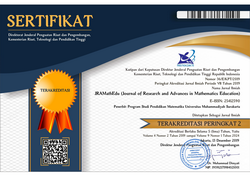Developing Realistic and Child-friendly Learning Model for Teaching Mathematics
Nining Setyaningsih(1*), Sri Rejeki(2), Naufal Ishartono(3)(1) Department of Mathematics Education, Universitas Muhammadiyah Surakarta, INDONESIA
(2) Department of Mathematics Education, Universitas Muhammadiyah Surakarta, INDONESIA
(3) Department of Mathematics Education, Universitas Muhammadiyah Surakarta, INDONESIA
(*) Corresponding Author
Abstract
Keywords
Full Text:
PDFReferences
Ada, J. H. (2016). The contribution of teachers’ pedagogical competence toward the effectiveness of teaching of english at mtsn balang-balang. ETERNAL (English, Teaching, Learning and Research Journal), 2(2), 238–251.
Anif, S. (2012). Profesi Guru : Antara Konsep, Implementasi dan Pola Pembinaan. Surakarta Indonesia: FKIP-UMS.
Arnold, K., & Lindner-müller, C. (2012). Assessment and development of social competence : introduction to the special issue Assessment and development of social competence : introduction to the special issue. Journal for Educational Research Online, 4(1), 7–19.
Gravemeijer, K. (1994). Developing Realistic Mathematics Education. Utrecht: CD-b Press.
Hakim, A. (2015). Contribution of Competence Teacher ( Pedagogical , Personality , Professional Competence and Social ) On the Performance of Learning. The International Journal Of Engineering And Science (IJES), 4(2), 1–12.
Hw, Slamet, & Setyaningsih, N. (2010). Pengembangan Materi dan Model Matematika Berbasis Media dan Berkonteks Lokal Surakarta Dalam Menunjang KTSP. Surakarta Indonesia.
Johnson, E. B. (2008). Contextual Teaching and Learning : what is it and why it is here to stay. . California : Corwin Press Inc.
Krisnandari, C., Ardi, M., Darwis, M., & Tahmir, S. (2015). The Application of Realistic Mathematics Education Approach In Teaching Mathematics In Kupang. International Journal of Education and Information Studies, 5, 35–43.
Krulick, S. & Rudnick, J. A. (1999). Innovative Tasks to Improve Criticalnand Creative Thinking Skills. In Developing Mathematical Reasoning in Grade K-12, pp. 138–145. USA: Prantice Hall.
Leontyev, V. V., Rebrina, F. G., Leontyeva, I. A., & Gafiyatullina, E. A. (2016). Evaluation of the Development of Professional Competence in Undergraduates : Methodical Aspects. International Journal of Environmental & Science Education, 11(14), 6592–6602.
Lo, J.-J., & Watanabe, T. (1997). Developing Ratio and Proportion Schemes: A Story of a Fifth Grader. Journal For Research in Mathematics Education, 28(2), 216–236.
Plomp, T. (1997). Educational and Training System Design. The Netherlands: Univercity of Twente.
Rejeki, S., Setyaningsih, N., & Toyib, M. (2017). Using LEGO for learning fractions, supporting or distracting? AIP Conference Proceedings , 1848. https://doi.org/10.1063/1.4983954
Saragih, S. (2013). Peningkatan Kemampuan Komunikasi Matematika Siswa SMA di Simpang Ulim Melalui Model pembelajaran Kooperatif Tipe STAD. Jurnal Pendidikan Dan Kebudayaan Kementrian Kependidikan Dan Kebudayaan, 19(, 174–188.
Setyaningsih, N. (2010). Implementasi Model Pembelajaran Problem Posing Untuk Meningkatkan Kemampuan Berfikir Kritis Siswa. Surakarta Indonesia.
Setyaningsih, N. (2013). Implementasi Model Problem Based Learning Dengan Pendekatan Scientifik untuk Meningkatkan Pemahaman Konsep Matematika Siswa. Surakarta Indonesia.
Setyaningsih, N., & Rejeki, S. (2016). Developing A Mathematics Instructional Model Based On CFICR At Yunior High School. ICRIEMS.
Slamet, H. W., & Setyaningsih, N. (2010). Pengembangan Materi dan Model Matematika Berbasis Media dan Berkonteks Lokal Surakarta Dalam Menunjang KTSP. Surakarta Indonesia.
Veloo, A., Ali, R., & Ahmad, H. (2015). Effect of Realistic Education Approach Public Secondary Students In Riau, Indonesia. Australian Journal of Basic and Applied Science, 9(28), 131–135.
Widyastono, H. (2013). Minat Terhadap Profesi Guru, Pengetahuan Tenatnag Penilaian Hasil Belajar dan Kualitan Kurikulum Buatan Guru. Jurnal Penelitian Pendidikan Dan Evaluasi Pendidikan, Vol 19, 222–235.
Article Metrics
Abstract view(s): 1379 time(s)PDF: 1010 time(s)
Refbacks
- There are currently no refbacks.







